Chambers deployed to measure methane emissions from sheep
 © Kevin Milner
© Kevin Milner Methane emissions from sheep are being measured on UK farms to establish which genetics, feed types and systems produce the most.
The measurements are being taken by trailer-mounted chambers designed in New Zealand for this purpose in a project led by Scotland’s Rural College (SRUC), grant-funded by Innovate UK.
See also: Sheep breeding index reduces methane and betters performance
The portable accumulation chambers (PACs) can predict methane emissions in individual sheep from a variety of systems, including at pasture, as well as in multiple locations.
Air samples are collected and the methane concentration levels analysed.
Nicola Lambe, who is leading the PACs project at SRUC, said there was an urgent need to mitigate greenhouse gas emissions (GHGs) from sheep with more than 1.2 billion sheep in the world producing about 7m tonnes of methane.
There are few examples of where research is being used to implement breeding strategies to directly tackle these issues, she added.
“This is largely due to the difficulty in recording feed consumption and GHGs on an individual animal basis, especially in grass-based systems,” said Dr Lambe.
“The PACs will play an important role in starting to address this issue.”
The first UK farmer to use the chambers is Rob Hodgkins, who farms 2,500 sheep in Hertfordshire.
He said measuring emissions made environmental and economic sense.
“It will only be a matter of time before consumers will be able to look at labels on packets of meat that shows what they’re buying has come from – for example, a carbon-zero sheep,” said Mr Hodgkins.
